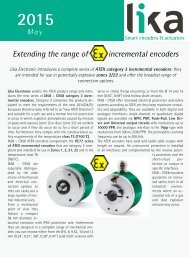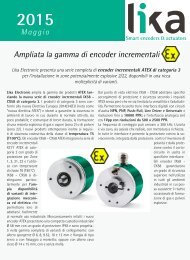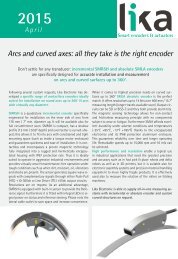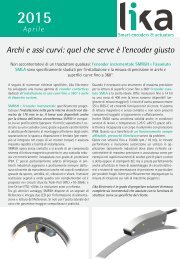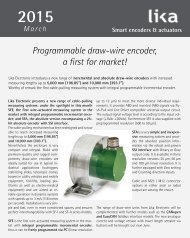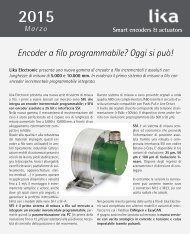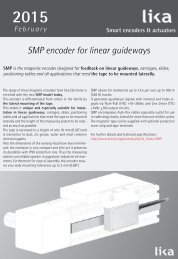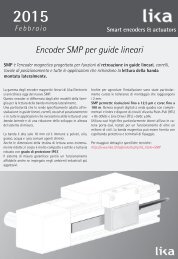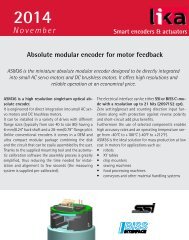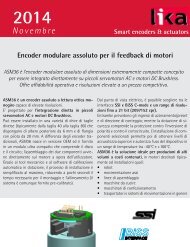LINEPULS & LINECOD catalogue 2016 in English
Lika Electronic incremental and absolute linear encoders catalogue 2016 in English Our new linear encoders catalogue is out now, and features many innovative new products and up-to-date information. The catalogue is expressly designed to set out the comprehensive range of incremental & absolute linear encoders from Lika Electronic. Check it out, it is completely renewed! Make sure you don’t miss out on a copy, download the pdf file from our web site or request your hard copy now! We have also got an interactive digital version in the works that shall be released soon!
Lika Electronic incremental and absolute linear encoders catalogue 2016 in English
Our new linear encoders catalogue is out now, and features many innovative new products and up-to-date information. The catalogue is expressly designed to set out the comprehensive range of incremental & absolute linear encoders from Lika Electronic. Check it out, it is completely renewed!
Make sure you don’t miss out on a copy, download the pdf file from our web site or request your hard copy now!
We have also got an interactive digital version in the works that shall be released soon!
Create successful ePaper yourself
Turn your PDF publications into a flip-book with our unique Google optimized e-Paper software.
<strong>LINEPULS</strong> • <strong>LINECOD</strong><br />
Sottotitolo Technical <strong>in</strong>formation<br />
L<strong>in</strong>ear encoders can be <strong>in</strong>cremental or absolute.<br />
Incremental l<strong>in</strong>ear encoders produce square waves signals or s<strong>in</strong>usoidal signals and can<br />
provide travel, position and displacement <strong>in</strong>formation. Positional <strong>in</strong>formation is cyclical,<br />
thus relative and ambiguous; this means that you can gather whether the axis is mov<strong>in</strong>g<br />
and the direction of the movement; yet you cannot get <strong>in</strong>formation about its absolute position.<br />
To compensate for this glitch the hom<strong>in</strong>g operation is always required at the beg<strong>in</strong>n<strong>in</strong>g<br />
of the process to determ<strong>in</strong>e the absolute position of the system (detection of the zero po<strong>in</strong>t;<br />
then it requires count<strong>in</strong>g of cycles to ma<strong>in</strong>ta<strong>in</strong> absolute position with<strong>in</strong> the travel range).<br />
For such reason most <strong>in</strong>cremental l<strong>in</strong>ear encoders can produce Index and/or Reference mark<br />
pulses provid<strong>in</strong>g a datum position along the tape for use at power-up or follow<strong>in</strong>g a loss of<br />
power. For detailed <strong>in</strong>formation on <strong>in</strong>cremental l<strong>in</strong>ear encoders refer to page 24.<br />
Incremental encoder<br />
An absolute l<strong>in</strong>ear encoder is designed to output the absolute position <strong>in</strong>formation <strong>in</strong><br />
response to motion along a l<strong>in</strong>ear path. It relies on a unique code pattern encoded on the<br />
tape, so it can provide a unique and unambiguous position with<strong>in</strong> the travel range without<br />
requir<strong>in</strong>g knowledge of any previous position. The major advantage is that you can always<br />
gather exactly the position of the axis. For <strong>in</strong>stance, <strong>in</strong> case of power loss or failure, then at<br />
power-up the absolute encoder will be able to output the current position of the axis precisely.<br />
This means that no hom<strong>in</strong>g operation is required to determ<strong>in</strong>e the current position.<br />
An absolute encoder provides the motion controller with either analogue signals or a digital<br />
code <strong>in</strong>formation. The digital <strong>in</strong>formation can be <strong>in</strong> pure B<strong>in</strong>ary or Gray code format.<br />
Customarily the absolute encoder encompasses serial (SSI, BiSS) output circuits, but it can<br />
also afford analogue and fieldbus <strong>in</strong>terfaces.<br />
For detailed <strong>in</strong>formation on absolute l<strong>in</strong>ear encoders refer to page 34.<br />
Absolute encoder<br />
At a glance: L<strong>in</strong>ear Encoder typical features<br />
10




